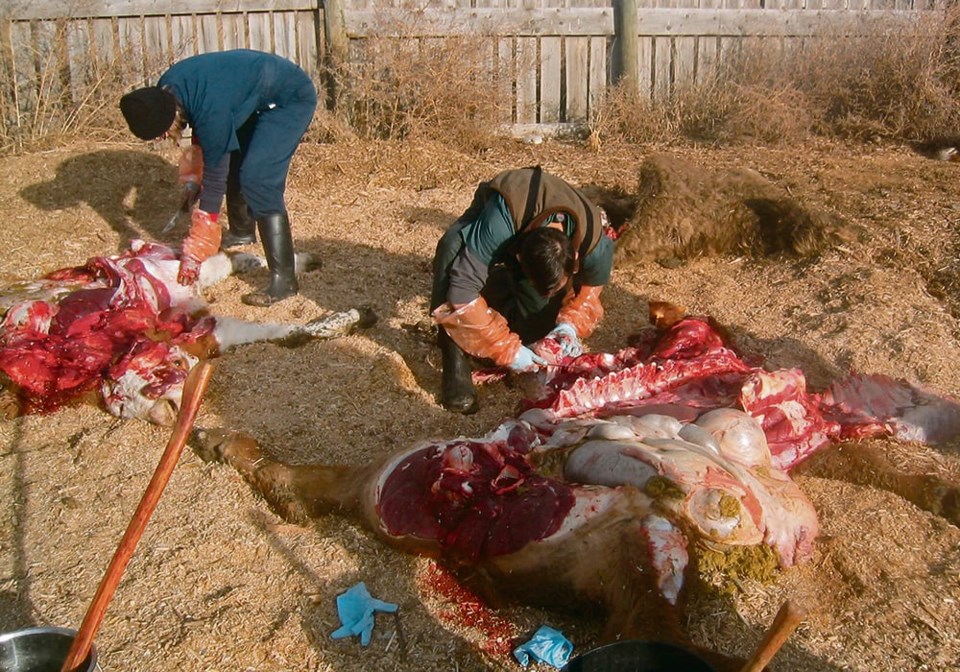WESTERN PRODUCER – Televised necropsies may be the next big thing in determining causes of death in cattle and other livestock, according to results of a proof-of-concept research project.
Using video conferencing technology, researchers with the University of Calgary Faculty of Veterinary Medicine found that connecting specialized pathologists with in-the-field large animal veterinarians in real time delivered a definitive diagnosis for dead cattle 98 per cent of the time.
Unassisted necropsies or post-mortems in the field only reached a definitive diagnosis 67 per cent of the time, so the video conferencing option is significantly more likely to result in a diagnosis, said lead researcher Jennifer Davies.
“Ultimately, when we reach a diagnosis in these cases, that equates to better use of producer money and veterinary resources in these investigations,” she said.
“That allows the vets to have a definitive diagnosis and evidence to make decisions on herd treatments and management. I think it shows the value of veterinary lab diagnostics as well to the producers.”
The Beef Cattle Research Council-sponsored project focused on beef cattle but it could be adapted to all types of production animals, Davies said.
“I think we have a need and desire for the service. I think it would support multiple different commodities throughout the province. And right now, our lab is exploring options to move this from the research arena into a service that we can offer to veterinarians in Alberta.”
While Davies was optimistic about telepathology’s potential prior to the project, she was stunned by how effective it was.
“While I had suspected our diagnostic rate would improve through the use of this technology, I was a bit surprised just how much improvement we saw.”
Telepathology is fundamentally a response to geographical challenges. There’s a high ratio of cattle producers to veterinarian pathologists in Canada. The latter are rarely located in rural communities where they can readily perform on-site post-mortems.
Although veterinarians are trained to do routine post-mortems, pathologists provide specialization and expertise in the causes of disease and death. Post-mortem investigations can suffer without their input, said Davies.
“If we don’t understand why animals are sick and dying in Alberta, we don’t know what diseases we have here and what we don’t have here. And that leaves us open to missing new and emerging diseases.”
Another challenge is that it is frequently impractical and expensive to send whole bodies, particularly large livestock like cattle, to a lab. Telepathology offers pathologists the chance to see a body on-site while working with a vet to collect the most relevant samples.
The project had three objectives. The first was to determine if real-time pathologist assisted necropsies (RT-PAN) improved the chances of finding the cause of death compared to unassisted field post-mortems.
The second was to see whether pathologist assistance reduced the time and money involved in reaching a diagnosis.
Finally, researchers wanted to see if real-time post-mortems are useful and viable service options that could be offered to food animal vet practitioners by the diagnostic services unit (DSU) at UCVM.
The researchers used video calling to enable a pathologist at the DSU to help interpret pathology, guide collection of samples and see the site and animal as the post-mortem occurred.
The team worked with five vet clinics to collect 58 necropsies. Thirty-two were unassisted field post-mortems while the other 26 were RT-PAN. Locations were concentrated in southern Alberta mainly because the researchers targeted vet practices already using the DSU’s services, said Davies.
The challenges of using RT-PAN are largely technical. It’s highly dependent on strong communication services. This may limit use in remote areas with substandard internet access.
Even in areas with well-developed telecommunications, issues such as adverse weather conditions, poor video and audio as well as equipment challenges can create obstacles.
Davies said poor phone and internet connections are major limiting factors in some regions and there are no easy solutions. However, the team had backups in case of front-line equipment failure.
“There were certainly instances where we couldn’t necessarily establish video feed for conferencing, but perhaps cell service was still present in that area and then we could rely on phone conversations as well and that still had value.
“In the absence of having telecommunications in the area, then I think we have to go back to some of our more standard or tried-and-true methods of working with veterinarians out in the field. And that can be for them to take static images and email us digital photos of what they were seeing that helps to augment the case and our understanding.”
Another barrier is time, a limited resource for most large animal vets. However, a post-project survey of participants found they considered RT-PAN education a valuable use of time.
Respondents were also enthusiastic about the potential to build relationships between veterinarians and pathologists as well as opportunities for continuing education. The BCRC summary described both possibilities as “extremely valuable.”
Davies was surprised by telepathology’s potential for human connection.
“Both the veterinarians and pathologists at the lab reiterated on several occasions in the survey that this was a powerful tool for relationship building. And I would echo that I learned a lot from the veterinarians I worked with. I hope they learned a little bit from me as well,” she said.
“It just really showed me that when we work together in partnership as field veterinarians and pathologists, rather than working in silos, we can accomplish greater things.”




